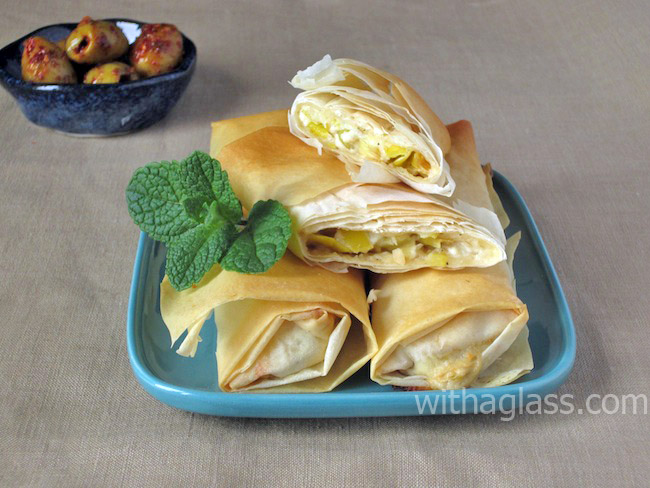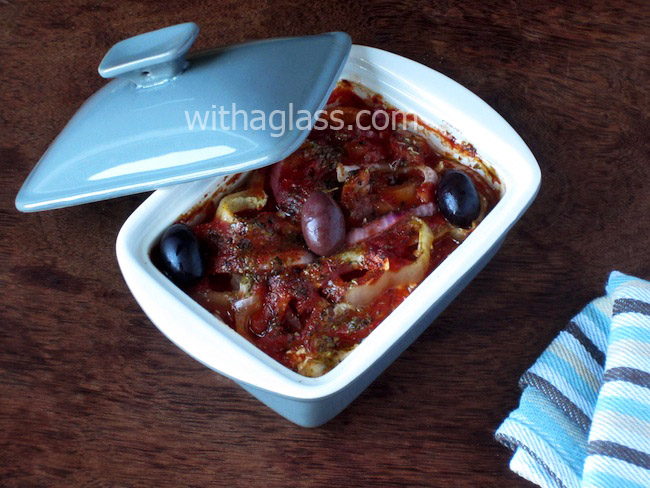Filo Rolls with Feta and Leek

I have finally found a fantastic brand of feta and cannot get enough of it. Although I like it best alone with a piece of good baguette, I have already had it in the traditional Spanakopita (see the recipe here) and in Pomegranate and Chicory Salad, but this time I decided to experiment with two beautiful leeks I found in my fridge. I wanted cute snacks and quickly opted for filo pastry rolls, much easier for my clumsy hands than the popular triangles. The simple combination of two ingredients: sweet, softened leek and sharp salty feta proved a fabulous filling idea. The only thing I regretted was the lack of dill, which I will add here next time.
If you are a fellow feta fan, you might like some of these ideas:




Preparation: 30 minutes + 30 minutes baking
Ingredients (serves two as a main dish with a salad or four as a small starter):
8 filo/phyllo pastry sheets
1 package of feta cheese (200 g/ about 7 oz)
2 big leeks (white and very light green parts only)
ground black pepper
(fresh dill)
1-2 tablespoons oil or butter
Preheat the oven to 180°C.
In the meantime chop finely the leeks and soften them in 1 tablespoon of oil in a pan on very low heat.
Put the pan aside.
Crumble the drained feta into the pan with leeks, add some ground pepper (and chopped dill, if you have it), stir well and with a spoon divide into 8 equal portions (this will make the filo sheets filling process much easier).
Spread one filo sheet on a big chopping board.
Place horizontally, about 2,5 cm/1 in. from the filo sheet’s shorter edge which is closest to you, a portion of feta and leek mixture.
Roll tightly but delicately, starting from the edge which is closest to you, folding the two lateral edges into the roll, so that the filling doesn’t leak during the baking process (I have folded here about 3 cm/about 1,2 inch on each side).
Proceed in the same way with the remaining rolls.
Brush the top of the rolls with some oil or melted butter, place on a baking tray or baking paper and bake in the oven until golden (about 30 minutes in mine). Watch them often as they tend to burn quite quickly.
Feta and leeks sound like another innovative way to use phyllo pastry.
Thank you, A_Boleyn. It’s not very original, but really excellent.
It’s new to me as was the chorizo, feta and spinach combination I tried recently. I have now used phyllo in 4 dishes though only 3 are distinctive recipes.
It’s funny because I have recently used also chorizo with filo (but without feta or spinach). I will write about it soon!
I have had spinach and feta in filo before and I really enjoyed every bite. I am sure feta and leek will be just as enjoyable as well. Oh this is making me hungry already Sissi. 🙂
Thank you, Ray. It has proved a delicious combination.
I know what you mean – there is good feta and then there is something someone calls feta. 🙂 I know it’s not suppose to be called feta unless it comes from Greece, but a local company here make a feta from sheep’s milk that we love. I don’t know how it compares to the real stuff, but I buy it all of the time. I would love to try it with leeks as I’ve never had a feta and leeks phyllo before. Sounds wonderful!
Thank you so much, MJ. Leeks were really delicious with feta! Here even some made in Greece Greek feta brands are not very good either (it happens with many foreign products: in their country of origin people are more demanding…). I can very well believe that your local feta is particularly good if it’s made according to rules; here we have a small mozzarella shop kept by Italians. They make mozzarella (and also some other Italian cheese varieties) from local milk. Mozzarella is made from raw milk and you can watch the man making it in the morning through a window which is left without curtains on purpose. Their mozzarella is almost as good as the good ones I had in Italy and even though it costs at least 3 times more than industrial one, I stopped buying the latter. Having their mozzarella is a real feast and I never add anything apart from excellent olive oil (tomatoes would destroy it I think).
Oh, I have just read the feta I liked so much contains 70% sheep milk and 30% goat milk (totally legal for a feta from what I read). It was less salty than usually and stronger in taste (the smell and the taste). This is probably why I liked it so much (I always had 100% sheep feta).
The sweetness of the sautéed leeks must really add to the flavors in your filo rolls.
Thank you, Karen.
I just used a package of phyllo dough for the first time, next time I will make this simple recipe…I like the spinach and feta cheese…looks delicious with the flaky dough.
Have a lovely weekend Sissi 😀
Thanks a lot, Juliana. Filo pastry has endless filling possibilities.
This looks so good, I loved the recipe, Sissi! I am a feta fan, but don’t experiment with it much at home. Your post inspired me to try more feta in my recipes. Thanks.
Thank you so much, Purabi, for this kind comment. I’m glad I made you want to experiment more.
I know what you mean about finding a brand of feta you like. The taste and texture can vary hugely and some varieties I’ve come across are not particularly appetizing at all :(. How great that you used a roll method here — I’m thinking my clumsy hands might even be able to manage it too 😉 — I have never made spanakopita (traditional or otherwise) but you keep inspiring me to try! The addition of leek sounds perfect here (amazing what gems lurk in our fridges 🙂 ).
Thank you so much, Kelly. I think that poor feta suffers as much as mozzarella from awful industrial almost inedible versions. Before tasting a good mozzarella, I used to be convinced it didn’t have any taste. How wrong I was…
I think I have abandoned the triangles for some time at least 😉 Rolls are so much easier for me! (I’m lazy so if I can simplify something or make the process quicker, I’m in heaven! Oops, I think I have already mentioned it some time ago 😉 ).
say it with me now: efficient (not lazy) 😉
You are so sweet, Kelly 🙂 I want to hug you! (And we don’t hug often in Europe).
xxx
Wow! The spanakopita sounds really good! You’re fantastic cook!
Thanks a lot, Nipponnin.
I know exactly what you mean about feta, Sissi…we usually only have access to Greek-Style or worse Canadian Feta and they don’t taste anything like REAL feta! A couple of years ago a grocery chain came out with French Sheep’s Milk Feta that was outstanding and not even THAT expensive, but we can no longer get it. I love the idea of putting leeks and feta together and these delicate pastries are beautiful. This would also make an outstanding lunch with a small salad.
We are expecting snow tomorrow morning, when will it stop?
Thank you so much, Eva. The very salty feta was really beautifully balanced by sweet soft leek here. I really liked this version of feta and phyllo snacks (and it’s also more convenient: I often have both filling ingredients in the fridge).
I think we all have the similar experience with feta… (apart from Katerina and other lucky Greek cooks who have access to the best feta in the world!). I still cross my fingers and hope you won’t have snowy Easter!
I love leeks in everything. Their sweetness when cooked is indispensable! I love your rolls Sissi and I make quite often a pie with leeks and feta!
Thank you so much, Katerina. I’m very proud you approve of these snacks. I didn’t know you combined feta with leeks too! I must have missed some jewels on your blog once more (or maybe you haven’t posted it yet?).
Thanks for this – this is a nice way to use up the filo I have in my freezer. Its been there for many months, probably more than one year:)
You don’t brush the filo with butter before rolling?
Thank you, Mr. Three-Cookies. I use only one sheet per roll, so there is no need to oil/butter it before rolling (I think it’s used mainly to keep the layers together). I brush it only on top before baking. It’s even easier like this, though maybe butter would add some additional crunch and taste…
Mm, what a timely post! I was just thinking of your spanakopita yesterday or the day before and thinking how lovely it would be to have it for dinner one evening. It’s that perfect dish which makes for a good meal on the warmer evenings we’re having these days.
What was the brand of feta? Perhaps we have the same one here, I’d like to see. The rolls look really good – they remind me a bit of the brik my wife makes. Have you tried them with brik pastry?
Thanks a lot, Charles. From what I saw on your blog, we both seem to have a “feta season” in our kitchens 🙂
It was actually a German (!) organic brand called Bio-verde. Since they sell to France, maybe you will find it also in Sweden? I swear it was a sensational feeling when I tasted it (and I was sceptical since it was not a Greek brand… I think they are allowed to call it feta also when the products are 100% Greek because it was written that the products came from Greek organic farms and the final transformation took place in Germany). Even Greek brands I had tasted (here we have several) never tasted that good… (I don’t mention the French or Swiss copies). What I liked most was the very cheesy strong taste and aroma and I think the fact that it contained 30% goat milk was also significant in it.
For now I stopped cooking with brick (I have been playing with it for years!) and I must say I’m pleasantly surprised how easy it is to bake filo rolls (I didn’t feel like deep-frying brick because it absorbed lots of fat due to tiny holes and I used to pan-grill brick, but it was easily burnt… baking in the oven was not as obvious as it is with filo).
This being said, I’m sure these rolls can be made with brick too. They can be used in a very similar way to filo, though the result is slightly different of course.